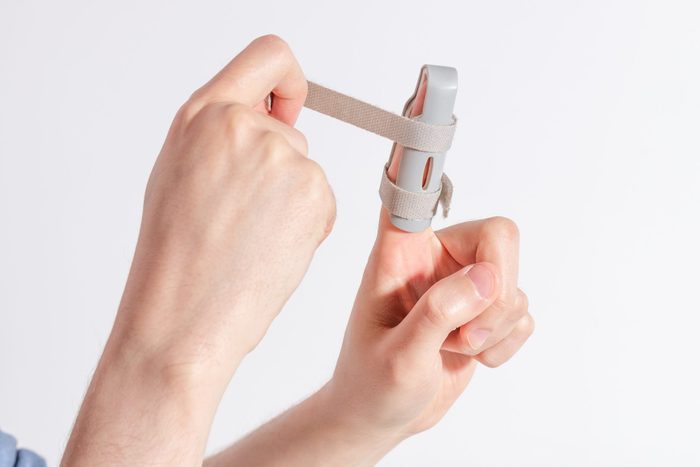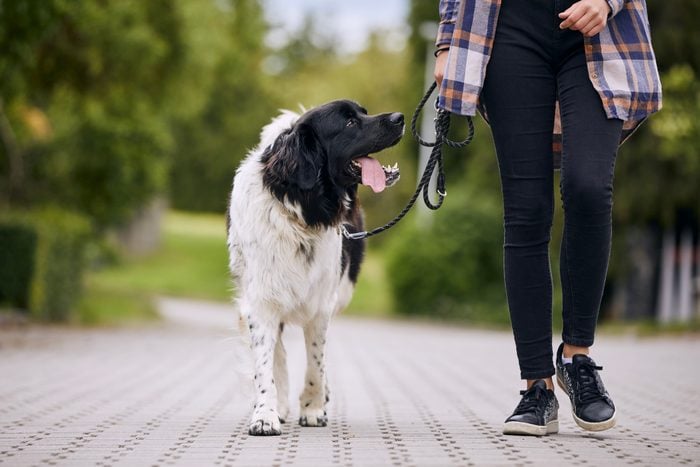
Walking your furry companion is a fantastic way to bond and stay in shape—with a catch. An April 2023 study says a reported average of 21,000 Americans every year experience a trip to the emergency room due to missteps with their pets.
The Johns Hopkins University study, published in Medicine & Science in Sports & Exercise, found that 422,659 adults visited emergency rooms in the US due to leash-related dog walking injuries between 2001 and 2020.
7 Health Benefits of Taking Your Walk Outside
Keep in mind that anyone can experience a fall from walking—but when they narrowed in on the most vulnerable demographics, the researchers found that women and adults aged 65 and older are more likely to sustain serious injuries, such as fractures and TBIs, while dog walking. Women with dog walking injuries were 50% more likely than men to sustain a fracture, while older dog walkers were more than three times as likely to experience a fall and 60% more likely to sustain a serious injury to the head than younger dog walkers.
While the average number of injuries comes out to around 20,000 per year, over the 20-year study period the estimated annual incidence of leash-dependent dog walking injuries more than quadrupled. The researchers believe this trend may be due to increasing dog ownership rates and the promotion of dog-walking for fitness purposes.
Because of this, Edward McFarland, M.D., senior author of the study and director of the Division of Shoulder and Elbow Surgery at Johns Hopkins Medicine called on clinicians in a recent press release. Dr. McFarland said: “We encourage clinicians to screen for pet ownership, assess fracture and fall risk, and discuss safe dog walking practices at regular health maintenance visits for these vulnerable groups. Despite our findings, we also strongly encourage people to leash their dogs wherever it is legally required.”
The study identified the three most common injuries from walking your beloved pooch, why certain groups are more susceptible, and how you can reduce your risk of injury.
Research Shows Owning This Type of Pet Could Extend Your Lifespan

1. Finger fracture
Finger fractures are the most common injury associated with dog walking. This can occur when your dog suddenly pulls on the leash or when you become tangled in it. Sudden jerks from your dog can place significant strain on your fingers, leading to fractures or dislocations.
To prevent finger fractures, you can take several precautionary measures:
- Use a comfortable, well-fitted leash that allows for a firm grip. Opt for a leash with a cushioned handle to minimize pressure on your fingers.
- Practice obedience training with your dog to reduce sudden leash pulling. Teach your dog commands like “heel” and “stop” to ensure a controlled, calm walking experience.
- Be mindful of your surroundings to avoid getting tangled in the leash. Keep your dog close to your side, and avoid wrapping the leash around your hand or fingers.
Vets Share Their 5 Best Tips for Safer Dog Walks—and 5 Things Never to Do

2. Traumatic Brain Injury (TBI)
Ouch: Traumatic brain injuries are the second-most-common injury related to dog walking. These injuries typically occur from falling after being pulled, tangled in, or tripped by the leash. Traumatic brain injuries can range from concussions to more severe nonconcussive internal head injuries.
7 Signs You May Need to Go to the ER After a Head Injury
To reduce the risk of TBIs, consider the following strategies:
- Be aware of your surroundings to avoid tripping and slipping hazards such as uneven surfaces, debris, obstacles or ice. Stay alert and maintain a clear path while walking your dog—and if the temperature reaches freezing, keep in mind that not only increases your risk of a fall, but the cold temps are also tough on your pup’s paws.
- Train your dog to walk at a steady pace without pulling on the leash. Regular training sessions with a certified pet trainer will help reinforce good behavior and create a more enjoyable walking experience for both of you.
- Consider using a hands-free leash or a harness to better control your dog. A hands-free leash wraps around your waist, allowing for better balance and reducing the risk of falls. At the same time, a harness distributes force across your dog’s body rather than the neck, which can reduce your pup’s pulling behavior. From READERSDIGEST.COM: The Best No-Pull Dog Harnesses, According to Pet Experts

3. Shoulder sprain or strain
The Johns Hopkins researchers suggest the third-most-common injury is a shoulder sprain or strain, which can result from a sudden pull or jerk by your dog. These injuries can cause pain, swelling, and reduced range of motion, impacting your daily activities.
To avoid shoulder injuries, adopt the following practices:
- Implement obedience training to improve your dog’s leash manners. A dog with this training is less likely to pull on the leash. This can reduce the risk of sudden shoulder strains or sprains.
- Use a body harness for better control and force distribution. A harness can help lessen the impact of sudden pulls, protecting your shoulder from injury.
- Maintain a proper posture while walking your dog to minimize strain on your shoulders. Keep your shoulders relaxed and avoid hunching or tensing up, as this can increase your risk of injury.
- Strengthen your shoulder and arm muscles through regular exercise and stretching, improving your ability to control your dog during walks.

Reducing your risk of dog-walking injuries
While dog walking provides various health and emotional benefits for you and your four-legged friend, it is essential to recognize the potential risks and adopt preventative measures to ensure a safe and enjoyable experience. Dedicating time to obedience training, utilizing the proper equipment, and remaining alert to your surroundings can significantly reduce the chances of injuries during dog walking.
Cultivating a strong bond with your pet and adhering to responsible pet ownership practices will pave the way for countless happy walks and promoting overall well-being for you and your canine companion.
Ready to unleash more health wisdom? Sign up for The Healthy @Reader’s Digest’s daily newsletter and follow The Healthy on Facebook, Instagram, and Twitter. We’ve got more right here:
- How Luke Russert Knew It Was Time for a Career Change: ‘There Was Something Missing’
- What Is Your ‘Set Point Weight’? Here’s How to Gauge It—And Why a Doctor Says You’ll Want To
- Are You Addicted to Drama? This Doctor’s 2-Minute Quiz Can Help You Find Out
- Here’s How Often You Need To Vacation To Prevent Premature Death, Says Overwhelming Research

